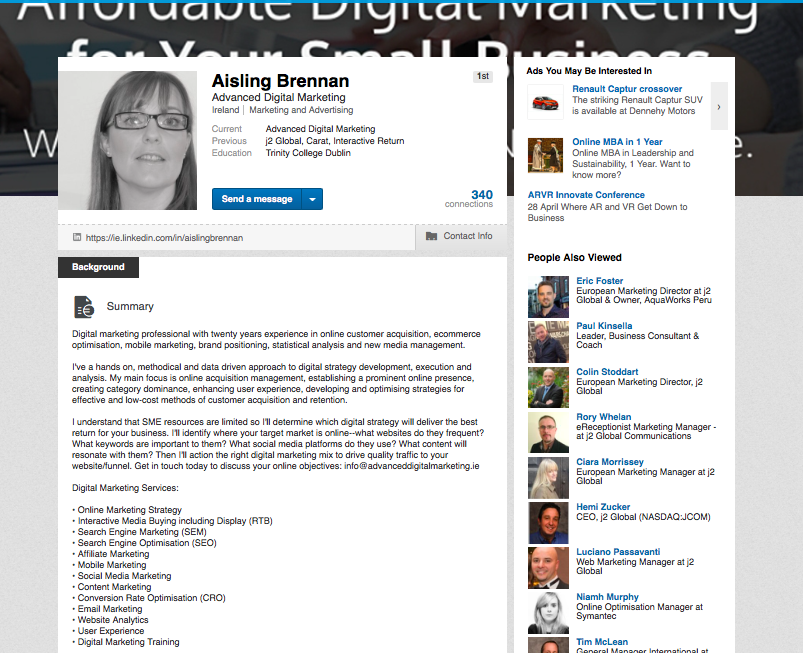LinkedIn 101: 40 Tips to Get Your Small Business Started
Aisling Brennan, 04-Apr-2016

Not just a platform for recruiters and job seekers, LinkedIn is great for building professional business relationships online. With over 414m registered members worldwide—of which 1m+ are based in Ireland--LinkedIn can be a powerful business building tool to attract quality leads and connections for your small business.

So, How Do You Get Started on LinkedIn?
1. Create an Individual Profile Page

First impressions count so create a comprehensive individual profile page. Remember this is not Facebook and the impression you give must be professional and credible:
- • Ensure your profile image looks professional – a crisp headshot facing the camera on a plain white/grey background will suffice. No late night party or holiday snaps please
- • Give some thought to the headline - the 120 characters should be concise, engaging and include your top keywords
- • Include a personalised cover image to make your profile stand out
- • Summary should speak directly to your target market, be written in the first person, include top keywords, be comprehensive and up to 2,000 characters in length and include rich media (Slideshare, tutorials, etc.), if available.
- • Current experience should focus on building your credibility, your products/services, call out any trophy clients, great testimonials and give a specific call-to-action.
- • Previous Experience should detail what you accomplished at any previous roles. Again, remember to include keywords in your titles and descriptions.
- • Publications section will help establish authority and thought-leadership in your sector. Include any content that showcases your expertise: reports, books, whitepapers, articles, etc.
- • Skills & Endorsements will increase your social proof and organic search ranking so aim to include at least 10 skills to your profile. Move those keywords that are most important to the top of the list. Remember to endorse others as many will reciprocate which helps build your social proof.
Once you have your individual page set up, the next step is to focus on creating your company page.
2. Create Company Profile Page
Similar to your individual profile, ensure your company profile page is comprehensive and detailed. Provide as much information as possible:
- • Imagery, colours, and content included should be consistent with your website and other social media profiles.
- • Include background information, service description, plus details like company size, press mentions, website address and contact details.
- • Set up a Showcase Page that highlights other business lines, products/services or events your company is hosting.
- • Don't forget to claim your custom vanity URL.
- • Build your reputation by posting high quality custom content regularly. Keep the content industry-specific and professional. Don't spam. Users appreciate valuable information – not endless useless updates clogging their feeds.
- • Avoid ALL hard selling – it’s a social network, not a sales network.
- • Note that your individual profile must be 50% complete, ranked Intermediate or All-Star before you can set up a company page. See the full list of requirements.
- • Connect your business and individual profiles.
3. Get Active & Start Networking
Once you've created both your individual and company profiles, now you can start networking. Remember the goal is not to broadcast how to great you are, but to get involved in the community, make as many connections are you can and get your connections to sing your praises for you:
- • Invite people you know well. Colleagues, ex colleagues, friends and close business associates, even family members can be a good place to start. Tip: Don't link your email account to invite those in your email contacts as this can lead to all sorts of (legal) headaches.
- • Add your LinkedIn URL to your email signature.
- • Examine the connections of your connections (2nd tier) to see if you can identify any potential prospects and influencers.
- - Reach out to your connections for introductions.
- - Customise any invitation message – don't use the default message and never leave it blank.
- - Remember that flattery goes a long way with introductory messages so include why you want to connect. Did you like an article/comment/blog post they wrote? Did you hear them speak at conference? Be forthright. Be complimentary.
- • Comment on any LinkedIn Group discussion that piques your interest. Try to add value to the conversation--don't just "like it" or "share it". The goal is to encourage engagement, so engage with it.
- • Join groups that are specific to your target audience, including any specific to your locality:
- - Share your content in a LinkedIn Group, but ensure it provides value to group members. Start with a question to stimulate conversation.
- - Review discussions and look for opportunities to engage or add value.
- - Also consider starting your own LinkedIn group/
- • If reaching out to potential prospects on LinkedIn always personalise your connection requests.
- • As with all social media don't use LinkedIn for hard selling – instead use to warm prospects into setting up a call.
- • For successful lead generation create a weekly task list:
- - Post relevant and engaging updates daily. Try to stimulate conversation by posing questions.
- - Share your blog posts on LinkedIn.
- - Engage with your connections' updates. Review your feed and regularly share and comment on other people's updates.
- - Accept any new Linkedin connection requests. Send welcome message to any new requests.
- - Make effort to build your network, connecting to prospects and clients.
- - Search for potential prospects using Advanced Search/Groups to find people in your industry or mine for leads.
- - Share custom content with some of your hottest prospects.
- - Don't pitch to new connections – remember it's a social network not sales network.
- - To convert a prospect to a client, move the relationship offline. Suggest a quick call to follow-up. But remember to take things slowly. No one wants to feel rushed.
- • Test LinkedIn Ads to reach a larger audience quickly and scale your efforts to increase visibility and generate leads through sponsored updates.
As with all social media, success won't happen overnight. Social media takes time (& patience & sweat). But if you follow the above tips you should start to see an improved volume of leads generated for your business in no time. As always, If you've any questions about LinkedIn--or indeed any other digital marketing tactic--please don't hesitate to get in touch.
Good luck!
Which Social Network is Right for your Small Business?
Learn how to find the right social media network for your small business.
